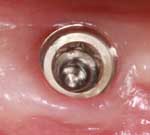 For more than twenty years, the first research dates back to 1984, teeth can be replaced by Osseointegrated implants.
For more than twenty years, the first research dates back to 1984, teeth can be replaced by Osseointegrated implants.
It is possible to replace a single tooth, several teeth or all teeth both of the mandible and the lower jaw.
Research over the past twenty years now confirms a success rate of over 90% in almost all cases.
The success rate is reduced according to bone quality, localization, and patients who smoke.
Clinical Procedure
After a careful clinical evaluation by the dentist, accompanied by X-rays which are more or less specific as appropriate; intraoral x-ray, orthopantomography, computerized axial tomography, the number of implants, the diameter and length are decided on.
The gums are incised and with calibrated cutters, the site for the implant within the bone is prepared. The implant is inserted and at this point there are several options depending on the different clinical situations:
- The implant is covered by the gums and will be subsequently reopened, after a period ranging from 3 to 6 months.
- The implant communicates with the outside through a screw and the tooth will be made after a variable waiting period.
- A tooth will be screwed onto the plant immediately after its insertion.
 Only the dentist can decide which solution to choose depending on the patient, age, type and quantity of bone, the location of the teeth to be replaced, the presence of any inflammation, and the type of jaw muscle. In some cases the insertion of a tooth on a recently placed implant may lead to failure and the need for immediate removal!
Only the dentist can decide which solution to choose depending on the patient, age, type and quantity of bone, the location of the teeth to be replaced, the presence of any inflammation, and the type of jaw muscle. In some cases the insertion of a tooth on a recently placed implant may lead to failure and the need for immediate removal!
Special Cases
The bone is not always present and sufficient to be able to insert implants.
If the bone is deficient in the simplest cases, it can be increased with “synthetic” bone graft and absorbable or non-absorbable membranes.
In other cases the bone is taken from other parts of the mouth. In more serious cases to increase the bone it is necessary to take it from other parts of the body.
Types of implants prosthesis
Teeth that are very similar to natural teeth can be made on implants: it becomes difficult to distinguish an actual tooth from an implant tooth.
However, implants can be used to fix and make removable prosthesis more stable. These solutions have a lower cost.